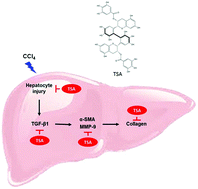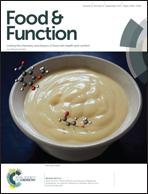Protective effects of theasinensin A against carbon tetrachloride-induced liver injury in mice
Abstract
Theasinensins have been identified as a major group of unique catechin dimers mainly found in oolong tea and black tea. Among several types of theasinensins, theasinensin A (TSA), an epigallocatechin gallate (EGCG) dimer with an R-biphenyl bond, is the most abundant theasinensin prevalent in oolong tea. Previous studies have reported that TSA exhibits antioxidative, anti-inflammatory and anti-cancer activities in vitro and in vivo. However, little is known about the hepatoprotective effect of TSA. Thus, the aim of this study was to investigate the inhibitory effect of TSA on carbon tetrachloride (CCl4)-induced hepatic fibrosis in mice. After intraperitoneal injection of CCl4 for eight weeks, histological lesions in the liver tissue and elevated serum levels of alanine aminotransferase and alkaline phosphatase were found in mice. Conversely, oral administration of TSA relieved CCl4-induced liver injury as well as ameliorated liver functions. Our immunohistochemical staining results revealed that collagen deposition was profoundly reduced due to supplementation with TSA. In addition, we also found that hepatic α-smooth muscle actin (α-SMA) and matrix metallopeptidase 9 (MMP-9) expression was suppressed through the inhibition of transforming growth factor β (TGF-β). Taken together, our current findings suggest that TSA may serve as a potent bioactive constituent from oolong tea that acts against liver fibrosis through the inhibition of hepatic stellate cell (HSC) activation.



 Please wait while we load your content...
Please wait while we load your content...